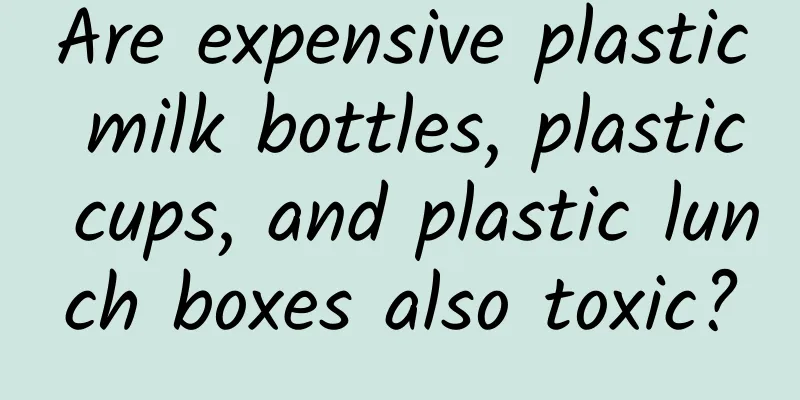Are expensive plastic milk bottles, plastic cups, and plastic lunch boxes also toxic?

|
Author: Han Fei (Center for Excellence in Molecular Plant Sciences/Institute of Plant Physiology and Ecology, Chinese Academy of Sciences) The article comes from the Science Academy official account (ID: kexuedayuan) —— Many people know that plastic products contain bisphenol A (BPA), which is toxic if ingested in excess. However, we often need to use various plastic bottles, cups, lunch boxes, etc. in our daily lives, so what should we do? - Buy expensive ones! In fact, expensive ones are not necessarily safe~ Baby bottles were once the hardest hit by BPA. Image source: https://www.livescience.com. What is the toxicity of BPA? Let’s talk about the toxicity of BPA first: BPA is the raw material for synthesizing polycarbonate (PC) and epoxy resin. After entering the human body, it has a strong estrogen-like effect, so it is an endocrine disruptor. It can cause precocious puberty in girls, which is the "lightest" harm; more seriously, it can lead to a decline in the reproductive function of both men and women, such as a decline in the vitality of sperm or eggs, and can also lead to various diseases or cancers, such as heart disease, diabetes, liver failure or prostate cancer, breast cancer, etc. It can also affect the development of the brain's nervous system and immune system, so it is quite harmful to infants and young children! These toxic effects were discovered accidentally by Patricia Hunt's laboratory at Washington State University 20 years ago (1998). They found a large number of sperm and egg cells with chromosomal abnormalities in mice released from BPA-rich plastic cages. However, after their paper was published, and before a large number of cross-species replication papers were published, BPA was still widely used around the world until the toxic effects were thoroughly confirmed! Countries have begun to make up for their losses: Denmark first banned the sale of BPA-containing children's food contact materials and articles in July 2010; in March 2011, the European Union banned the sale of baby bottles containing BPA; from June to September 2011, China completely banned the production, import and sale of baby bottles containing BPA; in July 2012, the US Food and Drug Administration (FDA) banned the sale of baby bottles and children's drinking cups containing BPA...Among them, many places in the United States, such as California, Alaska, Arkansas, etc., have expanded the ban on BPA to recyclable food or beverage containers for children under 7 years old. But what about adult water cups? And other plastic products or metal inner wall coatings, do they still contain BPA? Yes! Due to the controversy over the safe dosage, the "legal scope of application" of BPA is still wide. In China, PC material water cups containing BPA are still legally sold on e-commerce websites. According to the author's investigation, under those beautiful colorful water cups, there are many comments lamenting "really cheap..." Maybe they should think about: why are they so cheap? ! Aged and damaged polysulfone resin (PSU) lunch boxes release BPA and more BPS. Image source: Reference 1. Are BPA substitutes still toxic? BPA is difficult to completely replace. It has many uses, such as making plastic products colorless, transparent, and durable, and preventing fruits and vegetables from corroding metal containers, etc. (So BPA is also found in the coatings on the inner walls of many metal containers). Therefore, after being banned on a "small scale", BPA substitutes are bound to emerge: bisphenol S BPS, bisphenol F BPF, bisphenol AF BPAF, bisphenol fluorene BHPF, etc. Among them, the annual production of BPS alone in the European Union is 1,000-10,000 tons. They are widely used in food packaging boxes, the inner walls of food cans, baby bottles and children's water cups, and paper products. However, BPS is still reproductively toxic: In 2015, a study published in PNAS found that even at low exposure levels, BPS can still harm the brain development of zebrafish; at high doses, BPS can cause oxidative damage to the testicular tissue of rats, with its estrogenic effect equivalent to that of BPA (4-60%) and its anti-androgenic effect equivalent to 25% of BPA; in addition, BPS also has a unique steroid hormone effect, which can cause an increase in 17-OH progesterone levels, leading to fat accumulation and obesity. In addition, BHPF is also reproductively toxic: In 2017, a study in Nature Communications found that BHPF, due to its strong anti-estrogenic effect, can cause comprehensive damage to the reproductive function of female mice: decreased uterine weight, decreased pregnancy rate, increased stillbirth rate, decreased birth weight of offspring, etc. A serum analysis of 100 male college students who frequently drank bottled water found that 7% of them had trace amounts of BHPF in their blood. BPA substitutes such as BPF and BPAF are also toxic: In 2018, an article in Current Biology found that various BPA substitutes can cause chromosomal abnormalities in sperm or egg cells of adult mice, as well as abnormal spermatogonial stem cells (SSC) in male pups, leading to a permanent decrease in the level of recombination in spermatocytes. Therefore, the harm of BPA and its substitutes can affect 2-3 generations of mice. The harm of BPA substitutes can span three generations. Image source: Reference 1. It is worth mentioning that the dosage of these substitutes used in the experiment is very low, equivalent to the level when humans use BPA-free plastic products: the safe dosage specified by the FDA is 50ng/g/d, and the dosage of each substitute used in the experiment is 20ng/g/d, which is far lower than the so-called safe dosage. This data supports the previous research results: as endocrine disruptors, BPA and its substitutes may not have a "safe dosage" under long-term exposure. However, Professor Patricia Hunt, the author of the 2018 "Current Biology" paper, was conservative and restrained in her statement: Plastic products containing BPA substitutes, such as PSU, will still slowly release BPA and BPS during normal use. They are toxic to organisms including mice, rats, zebrafish, and Caenorhabditis elegans. Therefore, more research is needed to determine the impact of BPA substitutes on human reproductive health. Of course, Professor Hunt also pointed out that chemical safety assessment agencies around the world face challenges in their actual work, simply because there are too many types of new chemical raw materials. Based on cost considerations, companies can legally introduce these raw materials, and some do not need to be specially labeled on the product ingredients. Therefore, before all parties reach a consensus, plastic water cups, plastic milk bottles, and plastic lunch boxes that may contain BPA substitutes will continue to be sold normally. There is still a long way to go to test the effects of chemicals on estrogen signaling pathways. Image source: https://image.baidu.com/. A few small questions: 1. Do you have similar problems with pacifiers? A: No. Pacifiers on the market are generally made of silicone and do not contain BPA. However, the fetus/infant is still at risk of exposure to BPS through umbilical cord blood/breastfeeding or milk bottles. 2. Is it okay if it is not heated? I bought a plastic wardrobe for my baby. Is there any problem? A: First, if it is a PC product (such as beverage bottles with a bottom number of 07, drinking water buckets, baby tableware, sports equipment, medical equipment, CDs or electrical appliances, etc.), BPA can also be released at room temperature, but the release rate can be accelerated by 40-50 times at high temperatures; secondly, BPA has a high transdermal absorption rate. Even plastic wardrobes made of ABS often contain tetrabromobisphenol A (BPA derivative, used as a flame retardant), but it is low in toxicity. Currently, only a small number of studies have shown that it may be toxic to the liver, spleen, hematopoietic system and thyroid of adolescent male rats at high doses. 3. Are there any problems with high-end water cups or baby bottles, such as Tritan copolyester cups, PPSU, and PP materials? A: Unlike PC, these three water bottles definitely do not contain BPA. However, manufacturers generally do not specifically mark whether they contain BPS or other substitutes. In addition, there is a court case: In 2007, Eastman Chemical Company launched Tritan copolyester. In 2011, many scientists claimed that estrogen-like active substances were detected in Tritan products, but Eastman Chemical Company won the lawsuit, and the judge finally ruled that "the parties are prohibited from continuing to claim that Tritan has estrogen-like activity." 4. Is there a safe dose of BPA or its substitutes? A: High doses of BPA or its substitutes are obviously reproductively toxic, but the effects of long-term exposure to low or very low doses of BPA below the "safe dose" are still controversial. However, the brain and immune systems of infants and young children are still developing and are particularly sensitive to BPA. Some studies have shown that long-term low-dose exposure to BPA can also interfere with the normal estrogen response pathway through the estrogen analog effect, causing cell apoptosis. Finally, I would like to share with you the advice of Professor Leonardo Trasande of New York University: 1. Try to avoid using plastic products with recycling marks 3, 6, and 7; 2. Try to avoid heating plastic products. Don’t forget that high temperature and physical damage will accelerate the leakage of BPA or its substitutes. 3. So-called food-grade PC products, such as barrels for bottled water, also have a lifespan, generally 2-3 years, and should be avoided from overdue use or exposure to sunlight; 4. Try to use glass or steel containers! References: 1. Horan et al., Replacement bisphenols adversely affect mouse gametogenesis with consequences for subsequent generations, Current Biology, 2018; 2. Yang Yunjia, Yin Jie, Shao Bing, Research progress of bisphenol A substitute - bisphenol S, Capital Public Health, 2016; 3. Hunt et al., Bisphenol a exposure causes meiotic aneuploidy in the female mouse.Curr.ent Biology, 2003; 4. Ejaredar M et al., Bisphenol A exposure and children's behavior: A systematic review. J. Expo. Sci. Environ. Epidemiol, 2017; 5. Hunt et al., Bisphenol A alters early oogenesis and follicle formation in the fetal ovary of the rhesus monkey. Proc. Natl. Acad. Sci. USA, 2012; 6. Fluorene-9-bisphenol is anti-oestrogenic and may cause adverse pregnancy outcomes in mice 7. Xiao Jinhuan, Wang Haiyu, Jia Xudong, Zhang Wenzhong, Fan Yongxiang, Li Zhihua, Toxicity of tetrabromobisphenol A to peripubertal male rats, Journal of Toxicology, 2017; 8. Josie Gausiuszl, Will there be an end to the toxicity of plastic? Global Science, 2014. |
>>: What can corn be juiced with (milk, pumpkin, carrot, banana are all good)
Recommend
Causes of yellow-green vaginal discharge
Female friends all have the experience that leuco...
Which is better, dried durian or fresh durian? Where does dried durian come from?
Durian Dried is made by carefully selecting high-...
Just after the start of school, a 9-year-old primary school student was diagnosed with this disease! Experts remind
Soon after school starts Yangyang (pseudonym), a ...
What should patients with coronary heart disease pay attention to when doing physical exercise?
introduction Coronary heart disease, the full nam...
Can car coolant be replaced by water? What should I do if the car water tank is broken and cannot be opened?
We all know that windshield washer fluid can be r...
What foods can’t you eat during confinement?
Pregnancy is a process that every woman goes thro...
There is always white stuff on the vulva
Reproductive health means healthy women. Due to v...
Can I still get pregnant if I have a pituitary tumor?
Pituitary tumor is actually a disease. The reason...
Can I have my teeth extracted while pregnant?
When you have a toothache, you need to go to the ...
How long does it take to test for pregnancy if I have irregular menstruation?
The menstrual cycle of women is very important fo...
[Popular Science] If you have the flu, does drinking electrolyte water help?
During the New Year's Day holiday, the risk o...
There is blood in the vaginal discharge suddenly, like menstruation
Leucorrhea is a normal female secretion. Whether ...
Why do doctors say not to pick your ears? Be careful of cancer!
Some people really like it Try your best to pick ...
Can foot soaking relieve dysmenorrhea? Is it effective?
Every time you have your period, you will feel pa...
Treatment of third degree cervical erosion
I believe everyone knows the importance of the ce...









